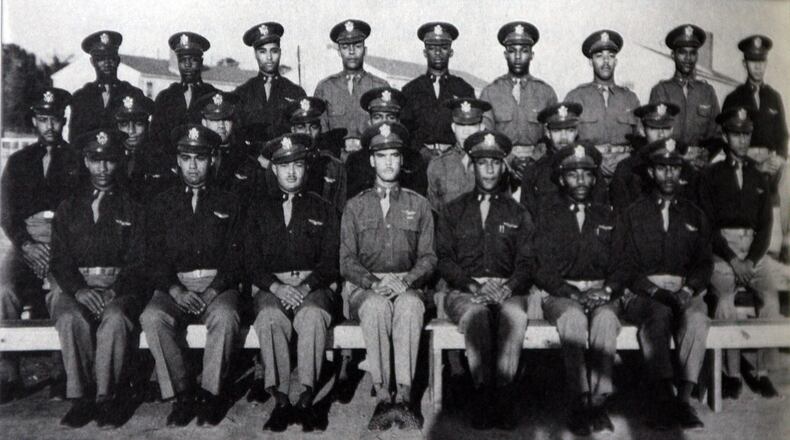Say goodbye to the Tuskegee Airmen.
Bid farewell to Women’s History Month, Holocaust Days of Remembrance and National Hispanic Heritage Month.
Scrubbing history is just one way federal agencies and contractors have responded to the executive order banning diversity, equity and inclusion programs in the federal workplace.
In the chaos that ensued, some of these actions, at least the ones that sparked public outcry, have been paused, reversed or revised.
Defense Secretary Pete Hegseth ordered the Air Force to restore the history of the Tuskegee Airmen to training materials, but the lesson was clear: The erasure of DEI programs would not only threaten efforts to diversify the workforce but could also result in the erasure of history and culture.
I thought about this a lot last week as the The Atlanta Journal-Constitution launched its 10th anniversary Black History Month coverage titled “Atlanta Unveiled: How African Americans Shaped our City.”
For the series, I wrote about Atlanta’s Black architects and the iconic buildings they have designed.
So many readers wrote to thank me for sharing the lives of these often unheralded builders of Atlanta. And some of them shared the names of other Black architects in Atlanta whose stories are less well known.
Since history is being erased as I write, I am going to share some of those names right here.
Cordell Ingram was a Tuskegee graduate who came to Atlanta in 1976 and worked on designs for Philips Arena and several venues for the 1996 Olympics.
In Ingram’s 2004 obituary, friend Robert Brown, another Tuskegee-educated architect, called Ingram a pioneer in getting important project management jobs for Black architects. Brown, who founded his Atlanta-based firm in 1984, has built a portfolio of schools, performing arts centers and other structures across DeKalb and Fulton counties that showcase his design talents.
Tarlee Brown (no relation to Robert), also a Tuskegee graduate, designed the Auburn Avenue Research Library, but his promising career was derailed when he was involved in a corruption case and told prosecutors he paid a kickback to Richard Arrington Jr., the first Black mayor of Birmingham, Alabama.
J. Max Bond Jr. — who designed Freedom Hall, the Administration Building and the reflecting pool at the King Center — spent part of his childhood in Atlanta, attending Booker T. Washington High School, before heading off to Harvard University and becoming one of the most influential Black architects of the 20th century.
Arthur Clement, a retired architect turned independent historian, was the first Black student to earn an architecture degree from North Carolina State University’s School of Design. He moved to Atlanta in 1975 after serving in the U.S. Army, one of the many Black architects summoned by then-Mayor Maynard Jackson (his cousin) to take part in the building of Atlanta.
Clement worked at Heery and Heery Architects with another Black architect named Rayford Newman. It was a small community and most Black architects in Atlanta crossed paths while working at larger firms or moonlighting for Black firms to make extra money.
Newman’s daughter, Helen Smith, told me her father was vice president at Heery and Heery and worked on the design of Martin Luther King Jr. Middle School and Peyton Forest Elementary School. He later joined the Black-owned firm J.W. Robinson & Associates, but died shortly after at age 39. A conflict over his role in the company led to a lawsuit, said Smith, who was only 13 years old at the time.
When her mother died last year, Smith discovered a trove of her father’s documents — his licenses, old articles and his briefcase still filled with papers. There was so much of her dad’s story she didn’t know, and she wanted to make sure others knew his name.
“It is important for young people coming up to hear these stories so they have a better appreciation of what can and cannot happen,” Smith said.
Smith wasn’t the only daughter who wanted to make sure her father’s legacy was remembered. I also heard from Rashida Trimble Winfrey, whose father, Tuskegee graduate Carl Trimble came to Atlanta in 1973.
Trimble was a founding member of the National Organization of Minority Architects and was known for aggressively pressing the Atlanta Committee for the Olympic Games to give 50% of design contracts and full partnerships to women- and minority-owned firms.
He wrote an editorial and took out a full-page advertisement in The Atlanta Journal, decrying the lack of opportunities for Black architects in public and private deals.
Trimble knew the problem wasn’t a lack of talent, it was lack of access. Black architects, he said, struggled to gain proximity to decision-makers who granted contracts to their friends and political cronies.
Now, the president who granted jobs to personal friends and political cronies wants us to believe everyone has “individual opportunity.”
When we erase the histories of people like Trimble or the Tuskegee Airmen, we lose those details that remind us how little has changed in two generations.
We forget the struggle and strife on which their accomplishments were built.
We sweep their stories under the banner of DEI and convince ourselves there is no work to be done.
Read more on the Real Life blog (www.ajc.com/opinion/real-life-blog/) and find Nedra on Facebook (www.facebook.com/AJCRealLifeColumn) and X (@nrhoneajc) or email her at nedra.rhone@ajc.com.
About the Author
Keep Reading
The Latest
Featured




